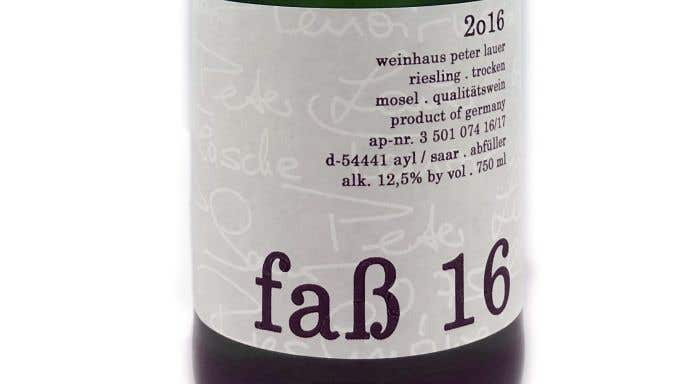From £14.60, €12.75, 19.90 Swiss francs
Following a quasi-dry January (made much easier by having discovered Seedlip) I’m enjoying wine again, particularly the current release of Peter Lauer’s Fass 16. Gulping this gorgeous, thirst-quenching wine is as refreshing as drinking pure spring water, but with masses of flavour packed in – a heady mix of pears, minerals and citrus. Julia gave it a very respectable 17 last year, praising its ‘saliva-inducing freshness and intensity’. It’s a super-fresh, glorious wine to end the day with – and at 12.5%, it’s also worth stockpiling for summer lunches in the garden (if/when summer ever comes).
I’m a firm believer in the importance of packaging and this box is ticked too – it’s very obviously a German Riesling but the label (pictured right) is clean, modern and original. There’s no hint of the chintzy Schloß imagery that can easily put off the uninitiated, and often doesn't reflect the style of the wine.
Technically this is a mere entry-level subregional blend, but it punches far above its weight. The Saar sub-region of the Mosel shares Mosel’s characteristically steep slopes and blue/grey slate soils, but at often higher elevations, making Saar generally even cooler than the Middle Mosel – hence the piercing acidity and freshness of the Fass 16 and other Lauer wines.
About half of the grapes for the Fass 16 are grown on the estate in the village of Ayl and the other 50% are bought-in grapes from other parts of the Saar. To maintain consistency between vintages, Lauer will buy grapes from parcels at different elevations and/or ask growers to pick earlier or later, depending on the conditions of the vintage.
Peter Lauer is a third-generation family business, started in 1913 and continued today by Peter's grandson Florian Lauer. Florian has more of a ‘natural’, non-interventionist approach in the cellar than his predecessors. Wines undergo a long, cool fermentation with ambient yeasts. This wine is filtered, but none are fined – Lauer’s wines are proudly vegan, using none of the animal products typical in fining. His hands-off approach explains the heap of (harmless) tartrate crystals that formed in the bottom of my glass, pictured below. Tartrates are common in wines from cool climates such as Germany's and are typically filtered out by adding metatartaric acid – something Florian says is 'against his philosophy'.
Lauer tries to reuse each barrel – or Fass – for the same wine each year, in an effort to maintain the individuality of each wine’s ambient vineyard yeasts that will kickstart each fermentation. Florian’s grandfather took this a step further and bottled each barrel separately – the original purpose of the Fass numbers appearing, albeit then very discreetly, on the label.
The use of Fass numbers on the labels evolved after 1971 when German wine authorities recategorised the name Ayler Kupp (the premium vineyards on the Kupp hill in the village of Ayl) as a catch-all name for all vineyards (of varying quality) in Ayl. From this point, further delineation of individual vineyards on the label was, crazily, prohibited. Lauer owned parcels of different vineyards, all with different aspects, on the Kupp. Fass numbers differentiated between the various single-vineyard wines and blends, with the Fass numbers becoming more prominent on the label over time. After a long battle with the authorities, Florian successfully fought to reinstate the pre-1971 names of the individual sites in 2014 and so today we see the likes of Unterstenberg, Stirn, Kern and Neuenberg on their respective labels. But the use of Fass numbers on the label has become part of the Lauer charm and thus is here to stay.
If Fass numbers have confused you in the past, worry not – even Wine-Searcher has learned something this week, amending their algorithms to be able to differentiate between them. Nevertheless, at the time of writing Wine-Searcher wasn't picking up all search results. Fass 16 is imported into the UK by Howard Ripley, where it retails for a rather reasonable £14.60 per bottle, and it’s widely available in Germany, eg GuteWeine or Weinhaus. I’ve also found it stocked in Ireland by Green Man Wines, in Switzerland by Flaschenpost and in The Netherlands by Winterberg Wijnen. In Scandinavia, it’s imported into Sweden by Climat Wines and in Finland by LCS Wines (trade only). Florian also tells me that you can order in Italy by emailing fabio@ilpostvino.it and you can also seek it out in Taiwan. Unfortunately the wine isn’t available in the US. Its off-dry brother, Barrel X, is the entry-level wine for the American market and that is widely available there, as are other Lauer wines.
Jancis adds Last night I enjoyed a glass of the 2015 vintage of this wine at the very carefully assembled wine list at the relatively new Taiwanese restaurant Xu in Rupert Street, London.
